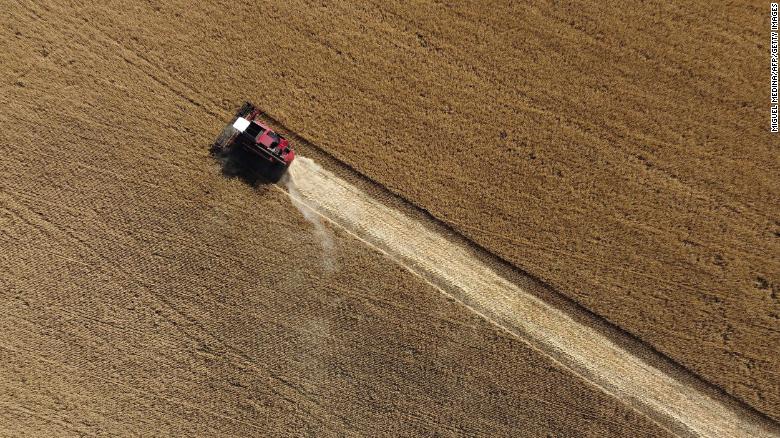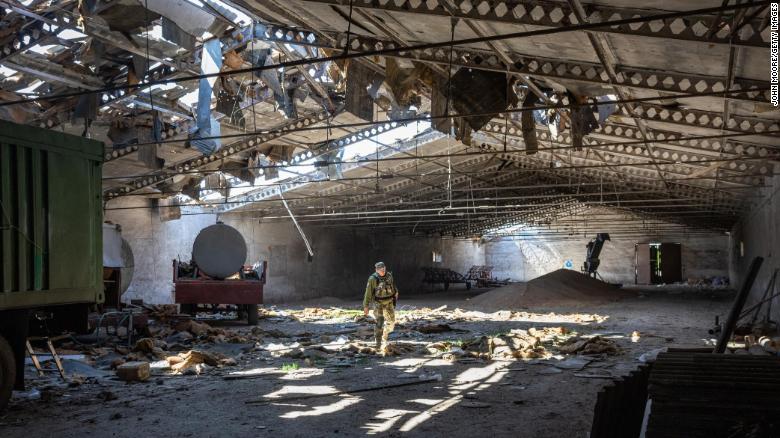As farmers across Ukraine attempt to bring in their wheat harvests in the coming weeks, it could be make-or-break for global food supplies.
Last year, Ukraine was the fifth largest exporter of wheat onto the global market. The invasion in February followed the planting of the winter wheat crop, which, despite the incursion of Russian tanks, is now ready for harvest.
But this harvest will be markedly different as the war continues to rage. Those farmers who have stayed are wary of unexploded missiles and ordnance that lie scattered in their fields. Some are musing burning crops rather than risk losing their combine harvesters and tractors — or their lives — bringing them in.

Adding to the crisis, Russia’s deliberate blockade of Odesa’s ports is preventing the grain harvested last year being shipped from Ukraine to import-dependent countries like Egypt, Libya and Somalia — all now in desperate need.
In occupied areas of Ukraine, there are reports of grain being illegally trucked to ports in Crimea, or even to Russia — and shipped out as Russian produce. The Ukrainian government claims over $100 million worth of grain (roughly 500,000 tons) has been stolen.
The conflict has simultaneously highlighted the reliance of developing countries on food imports and sparked a global price escalation, affecting both rich and poor countries alike and exposing what some have long feared: That our interconnected global food systems are far too fragile to cope with such shocks.
Before the war, Ukraine and Russia were together supplying 100% of Somalia’s wheat imports, 80% of Egypt’s and 75% of Sudan’s. If Ukrainian ports remain blocked, grain silos won’t be emptied and the new harvest may simply rot on the fields while millions go hungry.
The blockade of Odesa has been combined with Russia’s occupation, siege and assault on other surrounding ports, effectively cutting Ukraine off from the outside world. Efforts to attempt to move food out via Ukraine’s road, rail and river systems cannot match the capacity of bulk carriers leaving ports.
Part of this crisis is driven by the interrupted Ukraine exports and part by disrupted fertilizer supplies from Russia, China and Belarus — starting last fall. Russia is the world’s largest exporter of fertilizers overall. Disruptions, including economic sanctions now on Russian and Belarusian fertilizer exports, mean that fertilizer prices have skyrocketed and there are shortages.
Along with wheat, Ukraine is also the biggest exporter of sunflower oil and the fourth largest exporter of maize. By impeding the flow of grain from this breadbasket region, food becomes a powerful weapon in Russian President Vladimir Putin’s arsenal. This is nothing new for warmongers. For centuries, siege tactics have been deployed to starve populations.
What is new is that this tactic is not being deployed to subjugate the country under attack, but to hurt the world’s most vulnerable to create political leverage for Russia. Exporting stolen grain as “Russian” to Russia’s allies adds further insult to injury.
The United Nations’ calls to urgently lift the blockade have been met with demands that sanctions against Russia be lifted first. The Kremlin also denies allegations it is stealing grain.
Countries most reliant upon food imports now face being tipped into critical food insecurity. The World Food Programme’s director recently warned that 45 countries are one step from famine, and all around the world the poorest are suffering, because even in richer countries where food supply is not a problem, its price increasingly is.
Aid agencies are now reporting that they are struggling to maintain operations in vulnerable countries and other nations as far away from Ukraine as Peru, Sri Lanka and Turkey, which are facing instability as populations react in protest to spiraling costs and shortages. Facing their own domestic supply worries, 23 countries have restricted or banned exports of key crops and food supplies — which has in turn, further pushed up global prices and unsettled markets.
But while the immediate threat is deeply worrying, Ukraine’s conflict will likely not be over quickly. A battle of attrition may drag on for years — and Ukraine’s position as a major global supplier of wheat and sunflower oil looks under long-term threat.
Extreme weather matters
This is not the first time this century the world has been racked by a food crisis. In 2010, extreme heat in Ukraine and Russia seriously affected wheat harvests. This led to a run on the global market; poor policy responses added fuel to the flames, and rising prices drove up food poverty and triggered social unrest across the world, including helping spark the Arab Spring — the ripple effects of which are still with us today.
A similar food price spike occurred in 2007-2008, created by a combination of events, including a drought in Australia. The food system also creaked during the Covid-19 pandemic, where for many, access to food was curtailed.
If it weren’t for the backdrop of extreme weather combined with spiraling oil and gas prices, and supply chain issues, today’s food crisis might be manageable. But the global food system has both relied on the stability of good weather whilst undermining climate stability by creating greenhouse gas emissions at an alarming rate — some 30% of all emissions are related to the food system.
This is partly because fossil fuels are used to do everything from heat glasshouses to manufacture fertilizers. (The energy needed to produce nitrogen fertilizers explains why Russia, as a major oil producer, is the leading manufacturer and exporter.) Significant emissions also arise from clearing land for agriculture, coupled with an increased focus on producing cheap meat.
During the last 18 months extreme weather has blighted farmers around the world. Frost in Brazil, drought in North America, extreme heat in India, Italy, France and Spain, heavy rain in China, and flooding in South Africa have left damaged or lost crops in their wake. Climate impacts are only going to get more frequent and more intense — making the system more unstable.
Sadly, there are no quick-fix solutions. The knee-jerk response is often to try and get back to the status quo, rather than improving the system.
Beyond the cheap food era
Over 70 years, we have collectively designed a food system to deliver an excess of calories as cheaply as possible, with little focus on nutrition. The result is ever cheaper and more processed food, through long and complex supply chains, with the health and environmental consequences it brings.
All that is happening now means the era of cheap food may be over.
If it is, different solutions emerge.

Agriculture needs to wean itself off the fossil fuel drip. Using less fertilizer to save money, and the planet, may require farming in more environmentally friendly ways — shoring up the foundations on which farming rests, the climate, soil, water and pollinators.
Hedgerows and trees can help stabilize soils, store more water, and provide homes to creatures that control pests for free.
Across the world, more grain is now fed to livestock and used for fuel production than humans eat. In the European Union, including the UK, 61% of all grain produced gets fed to livestock, with only 23% being eaten by humans. A small change in the amount of meat people eat can potentially free up a lot of grain or land for food — whilst also being healthier.
Similarly, reducing food waste becomes a moral imperative.
Globally, about a fifth of all food grown for humans is wasted, every part a burden on the system.
Security actually means a diversity of domestic and non-domestic supply routes so if something goes wrong (think “mad cow disease,” “bird flu” or extreme weather) there are alternatives. It should also mean a supply of healthy, affordable food. But our current system doesn’t deliver that.
The war in Ukraine is showing us how badly the food system provides for people and the planet. There is another battle to fight with renewed vigor — for the future of the food system.
As reported by CNN
